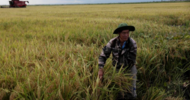
Lyudmyla Borkinets points to a field that she cultivates in the village of Hryshchyntsi in central Ukraine.
In fertile Ukraine, a 20-year freeze on the sale of farmland is lifted -- with uncertain consequences
By Mark Raczkiewycz
HRYSHCHYNTSI, Ukraine -- For small farmers in Ukraine, a traditional “breadbasket” that boasts some of the world’s richest soil, there’s something new under the sun this summer: They can sell their land if they want to.
Liliya Sytnyk doesn’t.
Like many of her neighbors in this village of 600 residents in the central Cherkasy region 125 kilometers (77 miles) south of Kyiv, an area known as the Sunflower Belt, she plans to hold onto her inherited land -- despite new legislation that took effect on July 1, ending a two-decade moratorium on the sale and purchase of a total of 42.7 million hectares (103 million acres) of fertile farmland in Ukraine.
“I would rather transfer ownership to my children and grandchildren,” said Sytnyk, 61, a subsistence farmer who leases 1 hectare to a nearby poultry producer that is the biggest in the country. “This is our heritage, our wealth.”
Lyudmyla Borkinets, who grows what she and her husband need to live off and leases about five hectares to the same poultry giant, also has no plans to sell.
But she hopes that buyers in the area will be small-scale farmers whose activity could help generate a thriving local micro-economy complete with local seed and fertilizer providers, and on a wider scale, help stem the demise of the country’s rural communities.
Borkinets, 63, said that the “big farms” -- those that cultivate more than 20,000 hectares -- “don’t register their companies in the communities in which they farm, so their tax money doesn’t go toward improving our villages.” And, she added, “their trucks damage our roads and they don’t contribute to repairing them or build new ones.”
Her hopes for thriving rural communities fit in with one of the aims of the reform that has been years in the making: to create incentive in what, until July 1, was one of a handful of countries left in the world that had not allowed the sale of agricultural land.
Lower Yields
Since 2001, some 7 million farmland owners in Ukraine had been unable to use their property as collateral to purchase or lease machinery, buy quality seeds, store grain in silos, and invest in new technologies.
The status quo has been a huge disincentive to farming operations, reform advocates say, discouraging investment and keeping Ukraine’s agricultural yields substantially lower than those in the European Union and the United States.
Barred from buying and selling, many Ukrainians who became owners of their land in the mid-1990s, following the collapse of the Soviet Union, have had little choice but to rely on subsistence farming while leasing whatever was left to bigger farming operations.
In the past, such leases have usually fetched an average of about $150 per hectare yearly, said Denys Bashlyk, who heads the Land Club, a consultancy that facilitates the purchase or lease of farmland as a source of residual income.
Ideally, the change could give farmers, landowners, and the country as a whole a big boost.
“Land reform that truly allows owners and users to take control of their land can be transformative,” Arup Banerji, World Bank regional country director for Eastern Europe, wrote in an opinion article in 2020.
“For landowners currently leasing out their land, this could provide up to $3 billion every year. For rural residents and small farmers, this can create some $24 billion of collateralizable assets that allow them to invest in irrigation, horticulture, or non-agricultural small enterprises. And for local communities and local governments, this can provide an income stream of up to $2 billion annually to better the lives of Ukrainians,” Banerji wrote.
Citing World Bank calculations, he wrote that “for Ukraine as a whole, this can permanently add almost one percentage point a year to economic growth.”
An April 2021 report by the International Monetary Fund (IMF), which is one of Ukraine’s largest foreign lenders and made ending the moratorium a condition for its latest loan package, forecast that economic output could increase by 6 percent to more than 12 percent over the next decade, depending on how well the reform is implemented.
Home to about a quarter of the fertile “black earth” soil on the planet, Ukraine is the world’s biggest producer of sunflower oil and the fourth-biggest producer of corn. Along with soybeans, sunflowers and corn are among the main crops grown in the Sunflower Belt, which stretches from Kharkiv in the east to the Ternopil region in the west.
Contentious Reform
About 30 percent of the country’s estimated population of 43.6 million live in rural areas, official statistics say. The farming industry employs more than 14 percent of the labor force, according to U.S. Commerce Department and World Bank data.
Agriculture constitutes nearly 10 percent of the economy and is its top export. The agricultural land market being created by the reform encompasses territory bigger than the area of Italy or California.
As of July 1, Ukrainians -- not foreigners -- can buy and sell up to 100 hectares. Starting in 2024, Ukrainian legal entities will qualify for transactions involving up to 10,000 hectares.
Whether foreigners should be allowed to buy land is one of the bones of contention surrounding the reform. President Volodymyr Zelenskiy has said he plans to put the question to the people in a nationwide referendum, but the outcome of such a vote seems all but certain: More than 80 percent of Ukrainians oppose it, according to an opinion survey conducted by the Kyiv International Institute of Sociology in June.
Since the imposition of the moratorium in 2001, politicians have used the topic as a tool of manipulation, according to Alex Lissitsa, president of the Ukrainian Agribusiness Club, an advocacy group for the farming industry.
It is a particularly sensitive matter in Ukraine, where forced collectivization and the deadly famine blamed on Soviet dictator Josef Stalin and his government looms large in historical memory, and “the issue has been politicized,” Lissitsa said.
Meanwhile, Ukrainians have begun buying and selling agricultural land. Between July 1 and August 10, more than 5,000 agreements were registered and more than 10,000 hectares sold.
However, for big farmer Kateryna Rybachenko, chief executive at Agro-Region -- a 40,000-hectare farm that spans four northern regions where seeds and grain are grown -- not much will change for now.
Due to the two-decade moratorium, in many areas of the country land lessees have become monopolists, leasing most or all the land on offer, and not much demand from other market players is expected, she said.
As a result, “not many people want to sell their land,” Rybachenko said.
Another potential barrier to an effective system: land disputes.
Only about 73 percent of the nation’s agricultural land has been mapped, leaving many boundaries unchartered and unclear, said Bashlyk, a former head of the government’s cartography and cadaster service.
“It’s too early to tell whether these communities will prosper after the reform,” Olena Shtefan, who heads the grouping of 24 villages that includes Hryshchyntsi, told RFE/RL.
For now, at least, the villages are like millions of small towns around the world in the eyes of many of those who grow up in them: places to get out of.
According to Borkinets, Hryshchyntsi saw 10 people graduate from high school this year.
“And the vast majority leave the village to study” in the district seat, the Cherkasy regional capital, or Kyiv, she said.












